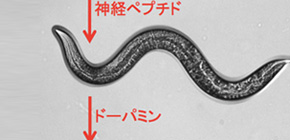
Complicated mechanisms for learning and memory partially elucidated
Role of neural transmitters elucidated through “odor learning” of C. elegans
A group of researchers from Osaka University, The University of Tokyo, and Ibaraki University clarified that two types of neural transmitter substances, neuropeptide and dopamine, play separate roles in the process of C. elegans' odor learning.
- Graduate School of Science, Osaka University -- YAMAZOE-UMEMOTO Akiko (completed the doctorate course in March 2015), FUJITA Kosuke (Specially Appointed Researcher, currently School of Medicine, Tohoku University), KIMURA Kotaro (Associate Professor)
- School of Science, The University of Tokyo -- IINO Yuichi (Professor)
- College of Engineering, Ibaraki University -- IWASAKI Yuishi (Lecturer)
C. elegans is used in experiments elucidating the basic structure of the animal body and brain. Although it is known that neurotransmitters play a critical role in learning in higher animals, the details have not been fully understood. This group's results are expected to lead to the understanding of mechanisms for learning and memory in higher animals.
Abstract
An animal's behavior is modulated by learning; however, the behavioral component modulated by learning and the mechanisms of this modulation have not been fully understood. We show here that two types of neural signalings are required for the modulation of different behavioral components in non-associative odor learning in the nematode Caenorhabditis elegans. We have previously found that C. elegans avoid the repulsive odor 2-nonanone, and preexposure to the odor for 1h enhances the avoidance behavior as a type of non-associative learning. Systematic quantitative analyses of behavioral components revealed that the odor pre-exposure caused increases in average duration of straight migration ("runs") only when the animals were migrating away from the odor source within a certain range of bearing, which likely corresponds to odor decrement. Further, genetic analyses revealed that the genes for neuropeptide or dopamine signalings are both required for the enhanced odor avoidance. Neuropeptide signaling genes were required for the preexposure-dependent increase in run duration. In contrast, dopamine signaling genes were required not for the increase in run duration but likely for maintenance of run direction. Our results suggests that multiple behavioral components are regulated by different neuromodulators even in non-associative learning in C. elegans.
Fig. 1. Different roles of neuromodulators on olfactory learning in worms revealed in this study.
Fig. 2. Behavioral patters of wild-type and mutant worms.
To learn more about this research, please view the full research report entitled " Modulation of different behavioral components by neuropeptide and dopamine signalings in non-associative odor learning of Caenorhabditis elegans " at this page of the Neuroscience Research website.
Related link
